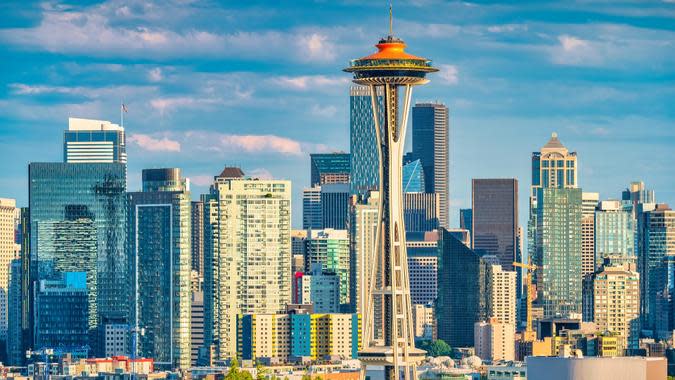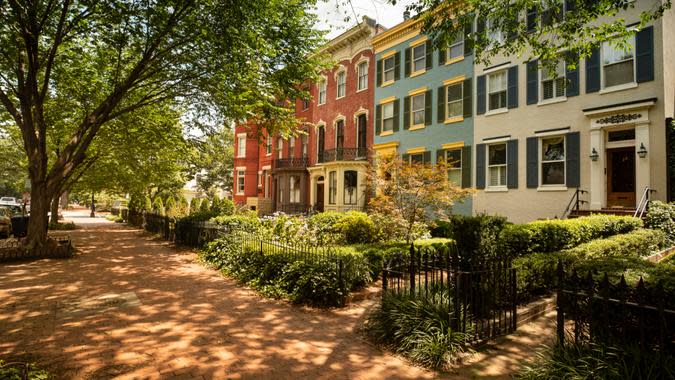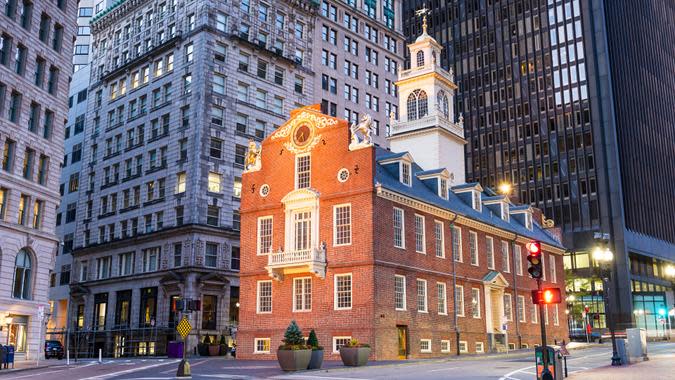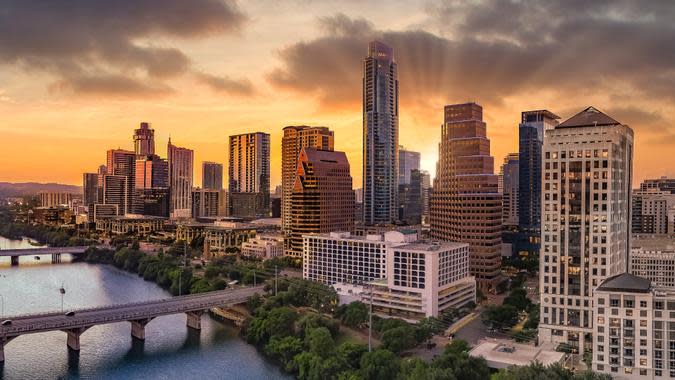How Much You Need To Go From Lower Middle Class to Upper Middle Class in 5 High-Cost Cities

Some of the best cities in the nation in terms of factors like job opportunities and entertainment also tend to be some of the most expensive places to live. In some of these high-cost-of-living (HCOL) cities, even earning above the national median household income — $75,149, according to U.S. Census Bureau data — could leave you in the lower middle class of that city on a relative basis.
Trending Now: A $150K Income Is ‘Lower Middle Class’ In These High-Cost Cities
Check Out: 4 Genius Things All Wealthy People Do With Their Money
For example, in Arlington, Virginia, which has the highest median household income in the country out of the 100 largest cities, you could earn as much as $152,652 — more than twice the national median — yet still technically fall into the lower middle class.
What follows is a list of five major HCOL cities in the U.S. and the amount you’d need to earn to move from the lower middle class to the upper middle class, based on a GOBankingRates analysis that combines Census data with the Pew Research Center’s definition of middle class: two-thirds to double the median income of an area.
Keep in mind that these aren’t exactly the top five in terms of the highest costs or salaries, but they are meant to represent a cross-section of popular U.S. cities with above-average incomes.

San Francisco
Median Household Income: $136,689
Lower-Middle-Class Range: $91,126 to $151,877
Upper-Middle-Class Range: $212,627 to $273,378
Cost of Living: 79% higher than national average
To go from the upper bound of the lower middle class to the start of the upper middle class in San Francisco, you’d need to earn an extra $60,750 per year.
Whether you live in the Bay Area or any other HCOL area, earning extra money like this often requires more than a simple side hustle.
“If you want to take concrete steps to earn more, you’ll want to understand what is required for a path of advancement in your line of work, and if there are any relatively easy ways to upskill yourself as a job seeker,” said Jeremy Bohne, founder at Paceline Wealth Management, LLC, based in Boston.
“Big changes in income are typically the result of advancement, choosing a new line of work, changing your hours or taking on a second job. Most people already work as many hours as they can, so taking an active role in understanding how to advance in your field is often the best choice,” he added. “And if you’re not satisfied with what you’re doing, considering a new line of work may be appropriate.”
Find Out: Net Worth for US Families: How To Tell if You’re Poor, Middle Class, Upper Middle Class or Rich
Read Next: Here’s How Much the Definition of Rich Has Changed in Every State

Seattle
Median Household Income: $116,068
Lower-Middle-Class Range: $77,379 to $128,964
Upper-Middle-Class Range: $180,551 to $232,136
Cost of Living: 50% higher than national average
To jump from the lower middle class to the upper middle class in Seattle, you’d need to earn at least an extra $51,587 per year. Seattle is particularly attractive to many tech workers, with companies like Amazon headquartered here. In particular, Seattle ranks as the top market for tech workers in terms of net gain of recent grads, according to a CBRE Americas Consulting analysis.
Explore More: The 50 Happiest States in America and How Much It Costs to Live There

Washington
Median Household Income: $101,722
Lower-Middle-Class Range: $67,815 to $113,024
Upper-Middle-Class Range: $158,235 to $203,444
Cost of Living: 39% higher than national average
While Arlington, Virginia ranks first for median income, Washington, D.C. itself isn’t too far behind. To go from the lower middle class to the upper middle class in the nation’s capital, you’d need to earn at least $45,210 above your current salary.
“Investing in your education and advanced degrees can be a great way to be eligible for positions with higher compensation,” said Patrick Marcinko, CFP, financial advisor at Bogart Wealth, located in the DC area. “There are many colleges and programs in the area that offer opportunities for people to enhance their education. In turn, this makes them more competitive applicants for future jobs.”
Like with other HCOL cities, “it is important to manage lifestyle creep within the D.C. area. It is crucial that you spend less than you make. The city offers so many low-cost or free events, like the museums downtown, that you can certainly keep busy without breaking the budget,” he added.

Boston, MA
Median Household Income: $89,212
Lower-Middle-Class Range: $59,475 to $99,124
Upper-Middle-Class Range: $138,775 to $178,424
Cost of Living: 50% higher than national average
Boston ranks ahead of its rival New York in terms of median household income. And while the gap between the lower and upper middle class in Boston isn’t quite as stark as it is in D.C., Boston has a higher cost of living. Here, you’d need to earn at least $39,650 more to jump from lower to upper middle class.
While the city is home to many prestigious places of higher education, you’ll have to weigh whether going back to school is likely to get you the ROI to make that leap in income.
“If you’re looking at ways to develop new skills, of course you’ll want to consider the cost of education compared to how quickly, and by how much, your income will change,” said Bohne.

Austin, Texas
Median Household Income: $86,556
Lower-Middle-Class Range: $57,704 to $96,173
Upper-Middle-Class Range: $134,644 to $173,112
Cost of Living: 1% higher than national average
Austin has been a popular place to move to recently, and with its growing tech scene, for example, salaries have also been on the rise, coming in a little above the national median. Here, you’d need to earn about $38,470 more to go from lower to upper middle class. The good news is that the city’s cost of living remains more affordable than many other high-income cities, in the sense that it’s just 1% above the national average.
Still, Austin could be considered an HCOL city considering its recent growth, above-average incomes and how housing costs have gotten particularly high here — 16% above the national average, according to Payscale.
“When moving to an area that has a higher cost of living than what you’re accustomed to, it is important to have a good handle on your money, particularly your expenses,” said Marcinko. “Before moving, research how much rent, transportation and other large expense items are, on average. Then compare this to your income and budget, so you are not surprised and end up overspending in those first couple of months to the area.”
And if you want room in your budget to invest in areas like upskilling, let alone enjoying yourself in your city, then it’s important to know your costs.
“It may not be the most fun exercise, but spend time tracking your expenses when you first move to the area. This will help you determine if you need to make any adjustments to your spending and habits to keep making progress financially,” Marcinko added.
Methodology: For this piece, GOBankingRates first used the 2022 American Community Survey to find the 100 largest cities in the U.S., in terms of total households. Once those cities were isolated, GOBankingRates found the median household incomes for all those cities. Then, we found the lower middle class income and upper middle class income ranges, following the Pew Research Center’s definition of middle class income as “two-thirds to double” the median income of an area. All income data was collected and is up to date as of Jan. 30, 2024. Cost of living information was sourced from Payscale.
More From GOBankingRates
This article originally appeared on GOBankingRates.com: How Much You Need To Go From Lower Middle Class to Upper Middle Class in 5 High-Cost Cities

 Yahoo Finance
Yahoo Finance 